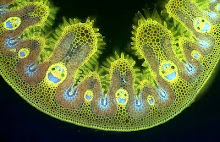A large prickly pear cactus, like this Opuntia macrocentra that comes from the Pecos region of Texas, is a thing of beauty when in full flower - although those long sharp spines can also inflict acute pain.
These magnificent flowers only last for a day and change colour to a more orange hue after pollination, which is apparently performed by bees. You can read an account of the pollination ecology of the plant here.
The fruits that form after pollination are edible in some species of Opuntia, notably O. ficus-indica, and marketed commercially as tunas that are popular in Mexico and occasionally appear on British supermarket shelves.
The stamens shed pollen soon after the flowers open in the morning but the stigma only becomes receptive in the afternoon and must be cross pollinated with pollen from a different individual plant before the flower will set seeds. The stamens are touch-sensitive, curling towards the stigma if you give them a gentle poke, mimicking the action of a visiting bee.
Flattened, jointed, photosynthetic stems called cladodes take over the function of leaves in prickly pears and most species defend themselves with long, sharp spines against grazing animals. These often have clusters of tiny, barbed hairs called glochids around their base and these are acutely irritating if the stick in soft flesh - like lips, for example. In a few species, like ...
... easily detached and break off at the slightest touch, so gently brushing against one of these glochid-covered cladodes can be a very unpleasant experience. For a really close look at these nasty microscopic harpoons, click here.
Both species illustrated here are growing in the desert house in Durham University Botanic Garden.



















